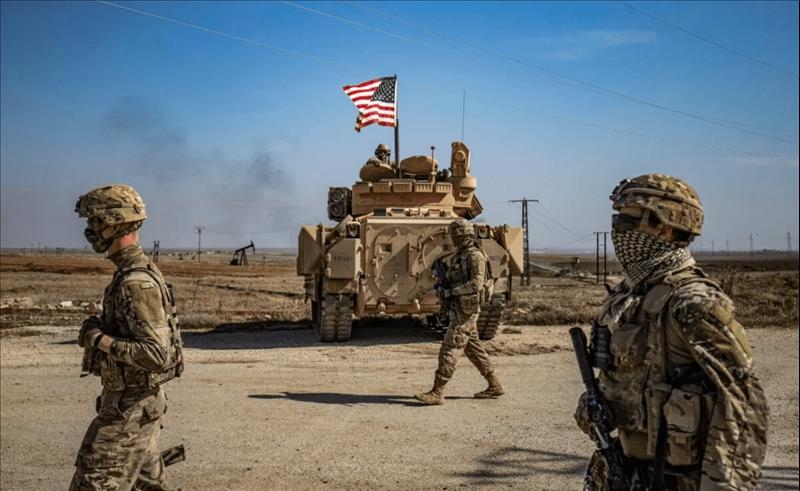
The risks from America's restraint in Syria
Last year saw a significant increase in the number of attacks against US forces in Syria, and that trend has already continued into 2022. This month, eight missiles fell on a military base hosting American troops in northeastern Syria, suggesting that there will be no let-up in the targeting of US soldiers.
While no organization has taken credit for the spike, an analysis of the circumstances surrounding the attacks, and the tepid American response, suggests two things.
First, the absence of US casualties indicates that a goal of those launching the strikes is to send messages rather than inflict damage. And second, Washington's conscious decision not to retaliate is emboldening these actors to use missiles as their primary means of communication.
The US is believed to have around 900 soldiers deployed in Syria. These troops are focusing on supporting the Kurdish-led Syrian Democratic Forces to maintain pressure on the remnants of Islamic State (ISIS) and to prevent them from recapturing territory.
In addition to their advisory role, American soldiers conduct regular patrol missions in northeastern Syria and participate in security operations against the extremist group's affiliates.
However, not all American troops are stationed inside the Kurdish-controlled region. Washington also has a relatively significant military presence in Al-Tanf, which is located on a strategic road connecting Tehran to Lebanon via Iraq and Syria. Hence the base is widely seen as part of the larger US strategy to contain Iran's military reach in the region.
This, among other reasons related to the historical rivalry between the US and Iran, has prevented Tehran from considering Washington a tactical friend against ISIS in Syria.
That is evidenced by the increased frequency of attacks against key US military locations in Syria. American forces have been reportedly attacked once a month, on average, since June 2021 – an unprecedented rate in the history of US operations in Syria.
Most of these attacks were carried out against US locations in Deir Ezzor, where operations against ISIS are centered. Despite its importance for Iran, the Al-Tanf base came second. That is because targeting US positions in the northeast is easier. Al-Tanf's location in Syria's Badia desert, which is flat and unpopulated, allows the US easily to spot and eliminate any ground attackers.
To overcome this operational obstacle, anti-US aggressors resorted to using unmanned aerial systems. Unlike the short-range surface-to-surface missiles that are used in other offensives, the use of drones requires more technical expertise and, hence, reveals valuable information about the identity of the attackers.
The drones used in these attacks are more sophisticated than the modified commercial devices used by groups like ISIS. More important, these drones are like the ones used against US airbases in Iraq.
The attacks in Syria also mirror the tactics used by Iranian-backed militias in Yemen and Iraq.
These findings, among others, strongly indicate that Iran or Iranian-backed groups are behind these incursions.
While expelling US forces from Syria seems to be the common goal of these assaults, the triggers that initiate them appear to vary. For example, the latest spate of assaults, which were coordinated in both Syria and Iraq, is believed to have been motivated by the desire of Iranian-backed factions to commemorate the second anniversary of the death of Qasem Soleimani, who was killed by an American air strike in January 2020.
Other attacks are suspected to be linked to the nuclear negotiations between the US and Iran, which are taking place in Vienna. Some believe that the assaults are being used strategically to influence those negotiations, while others think these incidents are arranged by hardliners to spoil the talks altogether.
Meanwhile, US and Israeli officials have said that Iran-backed groups in Syria, in addition to launching assaults in response to American air strikes, are also attacking American forces in retaliation for Israeli air strikes.
A report by The New York Times in November identified an armed-drone assault against Al-Tanf as the first Iranian retaliation against the US in response to an attack by Israel. Open data sources confirmed that the airbase was targeted a few days after unidentified drones hit Iranian-backed factions twice in a matter of days in the eastern countryside of Deir Ezzor. Those air strikes killed at least seven militia members, destroyed several weapons depots, and caused huge explosions in the area.
But these triggers are not new and cannot alone explain the motivation for the recent uptick in attacks against US forces. Hence the answer might lie in America's foreign policy under President Joe Biden's administration. The White House's decisions to withdraw from Afghanistan and end the US combat mission in Iraq have emboldened Iranian-backed militias to test Washington's boundaries in both Syria and Iraq.
More important, the US has refrained from aggressively retaliating against those involved in the attacks against its bases. Instead of identifying and punishing the groups responsible – through military or other means – America's reaction has been largely limited to targeting those doing the shooting.
Washington's soft approach is primarily due to its fear of jeopardizing the nuclear-deal talks with Tehran, as well as its desire to prevent military escalations in the region.
It is not clear if the United States' lenient approach will allow the White House to avoid these traps. But failing to make the price of attacking US forces intolerable will almost certainly fail to mitigate the risks that American soldiers in Syria are facing.
This article was provided by Syndication Bureau , which holds copyright.

Legal Disclaimer:
MENAFN provides the
information “as is” without warranty of any kind. We do not accept
any responsibility or liability for the accuracy, content, images,
videos, licenses, completeness, legality, or reliability of the information
contained in this article. If you have any complaints or copyright
issues related to this article, kindly contact the provider above.


















Comments
No comment